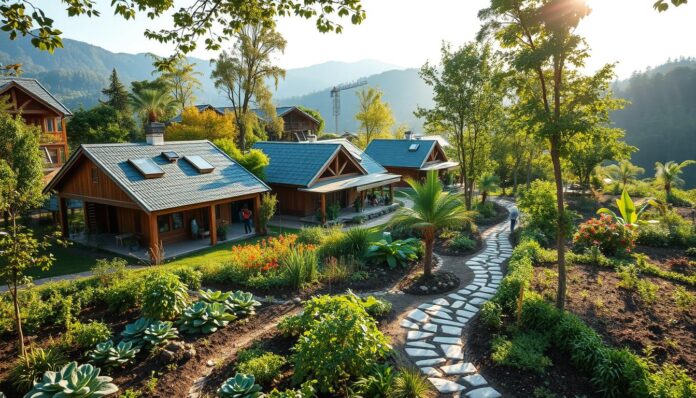The world is waking up to the need for sustainability. A big question is how can permaculture eco-resorts thrive and help the environment? With 83% of travelers now valuing sustainable travel, the need for green resort management is growing. Permaculture resorts lead this trend, using nature-friendly methods to lessen harm to the planet and offer unique natural experiences.
Eco-resorts can cut their carbon footprint and help local areas by using green practices. For example, the European Union’s Green Deal and New York City’s Local Law 97 will shape the hospitality world. These rules make green practices essential for permaculture resorts.
Key Takeaways
- Permaculture eco-resorts prioritize sustainability and environmental responsibility
- Sustainable hospitality practices and eco-friendly resort management are in high demand
- Energy efficiency and waste management are crucial for reducing environmental impact
- Permaculture resort operations can support local communities and promote biodiversity
- Adopting sustainable practices can lead to cost savings and increased revenue for eco-resorts
- Guests are willing to pay a premium for eco-conscious resorts that align with their values
Understanding Permaculture Principles
Permaculture design principles are key for sustainable tourism. They help eco-resort operators manage their places in an eco-friendly way. These principles focus on caring for the earth, people, and sharing fairly.
Earth care means keeping nature balanced and resources saved. People care is about helping local communities and fighting for justice. Fair share is about sharing resources and knowledge for a better world.
Check out the permaculture practice website for more on these ethics. By following these, resorts can lessen their harm to the environment. For instance, the Leitlhof hotel grows most of its food, reducing its need for outside help.
This is a big part of regenerative tourism strategies. They aim to make both people and the planet happy.
Some important features of permaculture in tourism are:
- Building with local, sustainable materials
- Using renewable energy like solar power
- Conserving water and cutting down on waste
- Supporting local communities and fighting for justice
Eco-resorts can offer a special, green experience to guests. They also help the environment and local people. This is crucial for a greener tourism industry, and permaculture leads the way.
Sustainable Land Management Practices
Sustainable land management is key to keeping ecosystems balanced and reducing eco-resort’s environmental footprint. It focuses on soil health, water conservation, and more. Eco-resorts can cut down water use, boost biodiversity, and help local ecosystems by using these methods.
Good green hotel operations and eco-resort management techniques include sustainable land practices. For instance, using rainwater and greywater systems cuts down water use. Also, rotating grazing helps increase plant and animal life on pastures.
Some important strategies for sustainable land management are:
- Soil health and regeneration through organic amendments and conservation tillage
- Water conservation techniques, such as rainwater harvesting and greywater reuse
- Integration of multiple species in permaculture practices to enhance ecosystem resilience
By using these sustainable land management practices, eco-resorts can lessen their environmental impact. They can also support biodiversity and local ecosystems. This is vital for eco-resort management techniques and green hotel operations that focus on sustainability and caring for the environment.
| Practice | Benefits |
|---|---|
| Soil health and regeneration | Increased fertility, reduced erosion |
| Water conservation techniques | Reduced water consumption, increased efficiency |
| Integration of multiple species | Enhanced ecosystem resilience, increased biodiversity |
Designing Eco-Friendly Accommodations
Creating eco-friendly resorts is key to reducing environmental harm. This means using materials like recycled wood and designing rooms that use less energy. It’s also important to focus on permaculture, which helps all living things live together in harmony.
Using low-flow toilets and faucets helps save water. Adding solar panels or wind turbines cuts down on fossil fuel use. Eco-friendly materials are better for the planet but might cost more upfront. However, they save money and the environment in the long run.
Eco-resorts can cut down on energy use and support local nature. For example, using plants native to the area helps wildlife and cuts down on chemical use. Composting toilets turn waste into fertilizer, reducing waste and pollution.
To be truly sustainable, eco-resorts can share resources and lower costs. This makes eco-travel more affordable. As more people seek green travel options, the need for eco-friendly resorts will grow.
Developing a Productive Garden
Permaculture resort operations focus on creating a productive garden. This helps reduce environmental impact and promotes sustainability. They choose crops that fit the local climate and use companion planting to boost biodiversity.
By doing this, eco-resorts can cut down on their need for outside food. They support local food systems and biodiversity. For instance, permaculture-based ecolodges in Costa Rica have made it work. They offer guests a chance to learn and experience nature up close.
Creating a good garden is key for eco-resorts. It lets them serve fresh, local food to guests. This helps reduce their carbon footprint. Here are some important steps:
- Choose crops that match the local climate and soil.
- Use companion planting to boost biodiversity and fight pests and diseases.
- Set up efficient irrigation systems to save water and cut down on waste.
Crop Selection for Permaculture
Choosing the right crops is vital in permaculture garden design. Eco-resorts pick crops that fit the local climate and soil. This reduces their need for outside help and supports biodiversity.
Permaculture design principles guide this choice. They ensure the crops work well with the local ecosystem. This helps keep the ecosystem balanced.
Companion Planting Strategies
Companion planting is a big help in permaculture gardens. It boosts biodiversity and fights pests and diseases. By planting different crops together, eco-resorts create a strong and diverse ecosystem.
For example, growing marigolds with tomatoes can keep nematodes and other pests away. This means less need for harmful pesticides. It makes the ecosystem healthier.
Integrating Animals into Permaculture
Adding animals to permaculture is key for regenerative tourism. It boosts biodiversity, soil health, and local ecosystems. Eco-resorts can lessen their environmental footprint and support local food systems by using holistic grazing and sustainable animal habitats.
Green hotels can also gain from adding animals to their permaculture. It makes the guest experience better and helps the local community. For instance, hotels can have on-site farms or gardens with animals like chickens or bees. This way, they can offer fresh food and cut down on external supplier costs.
Benefits of Holistic Grazing
Holistic grazing mimics natural grazing patterns. It improves soil health and biodiversity. This method can make the soil more fertile, reduce erosion, and boost land productivity.
Designing Animal Habitats
Creating sustainable animal habitats is vital for permaculture. Hotels can build natural habitats with shelter, food, and water for animals. This supports biodiversity and ecosystem services. For example, bee hotels or butterfly gardens can help local pollinators.
Eco-resorts can offer unique experiences by adding animals to their permaculture. This supports sustainability and local ecosystems. It’s a way to make tourism regenerative, focusing on both people and the planet.
| Benefits of Integrating Animals into Permaculture | Description |
|---|---|
| Promotes Biodiversity | Integrating animals into permaculture promotes biodiversity by creating habitats for a variety of species. |
| Improves Soil Health | Animals can help to improve soil health by providing natural fertilizer and promoting soil structure. |
| Supports Local Ecosystems | Integrating animals into permaculture supports local ecosystems by providing habitat for native species and promoting ecosystem services. |
Renewable Energy Solutions
Using renewable energy is key for eco-resorts. It helps them use less fossil fuels and be more sustainable. About 73% of travelers prefer places that care for the planet.
Renewable energy can save money and cut down on carbon emissions. Hotels using solar power can save over $1,500 a year. They might even make about $16,000 from selling energy credits.
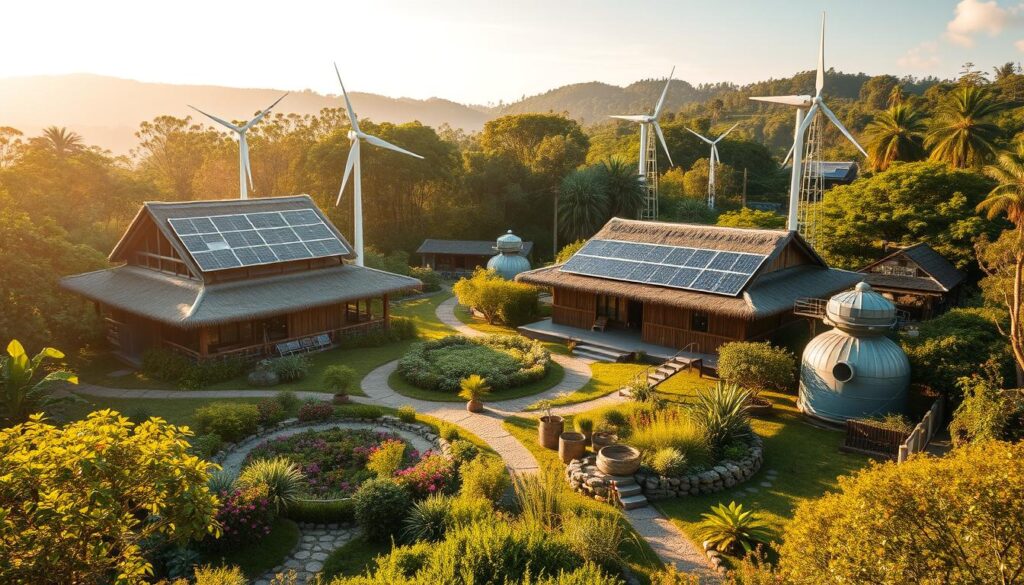
Renewable sources like solar and wind power are great for eco-resorts. They help reduce harm to the environment and support sustainability. This way, eco-resorts can lower their carbon footprint and help the eco-tourism market grow.
The benefits of renewable energy for eco-resorts include:
- Lower energy costs
- More sustainability
- Less carbon emissions
- Helping the eco-tourism market grow
By using eco-resort management, like renewable energy, we can make tourism greener. This leads to a more sustainable travel industry.
Establishing Community Partnerships
Building community partnerships is key for sustainability and supporting local ecosystems. Eco-resorts can lessen their environmental footprint and boost local economies. They do this by working with local farmers and engaging eco-aware guests.
Rancho Margot in Costa Rica is a great example. It’s known for its green and social success. The Mesoamerican Institute of Permaculture (IMAP) also shines, helping over 10,000 producers and teaching about 15,000 in conservation and Mayan traditions.
Collaborating with Local Farmers
Working with local farmers is vital for local food systems and lessening external reliance. Resorts can start farm-to-table programs to support local economies. This also helps in reducing environmental impact and preserving biodiversity.
Engaging with Eco-Conscious Guests
It’s important to involve eco-aware guests in sustainability efforts. Resorts can offer educational programs to teach about green practices. This teamwork helps in promoting a greener future and supporting local communities.
Marketing Your Eco-Resort
The need for green tourism is rising fast. It’s key for eco-resorts to market well. With 69% of travelers choosing green options, it’s vital to show what makes your resort special. This could be your farm-to-table food, cutting food costs by 30-50% a year.
Highlighting your eco-friendly efforts can draw in guests who are willing to pay more. Getting certified by LEED or Green Globe can boost your property’s value by 10-20%. 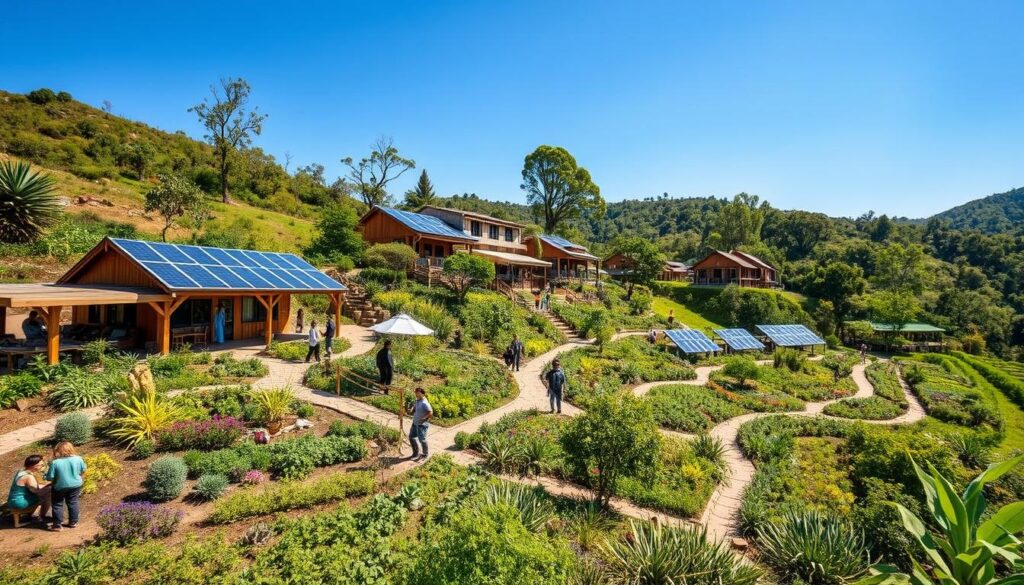
Here are some online marketing tips for eco-resorts:
- Use social media to share your eco-friendly practices and talk to potential guests
- Make content like blog posts and videos to teach about permaculture and green tourism
- Offer special deals that show your dedication to the environment
By using these tactics, eco-resorts can get more visibility and attract eco-aware visitors. As green tourism grows, it’s crucial for eco-resorts to lead the way in permaculture and sustainability.
Financial Sustainability of Eco-Resorts
For eco-resorts to thrive, they must focus on financial sustainability. This can be done by using eco-resort management techniques that save costs. These include lowering energy use, supporting local food, and finding new ways to make money. These steps help eco-resorts stay financially stable, support permaculture resort sustainability, and boost local economies.
Here are some ways to make eco-resorts financially sustainable:
- Offer eco-tourism activities and workshops
- Make spaces energy-efficient and cut down on waste
- Use sustainable land management
Studies show that eco-resorts aim for financial stability. They can achieve this by adopting a business model that follows permaculture resort sustainability. This approach helps them lessen their environmental footprint. It also helps the local economy and improves the lives of nearby communities.
| Income Streams | Description |
|---|---|
| Eco-tourism activities | Guided tours, workshops, and other activities that promote environmental conservation |
| Sustainable agriculture | Producing and selling organic products, such as fruits and vegetables |
| Renewable energy | Generating and selling renewable energy, such as solar or wind power |
The Role of Education in Permaculture
Education is key in promoting sustainable hospitality and permaculture resort operations. Eco-resorts can host workshops and events to teach guests about permaculture. This helps guests learn and supports local ecosystems.
Workshops cover topics like water management, erosion control, and soil building. These are designed for interns, students, and visitors. Hands-on learning is a big part of these programs. This way, permaculture resorts can grow more sustainable and help the local community.
Key aspects of educational programs in permaculture resorts include:
- Hands-on learning experiences
- Workshops and events on permaculture principles
- Informative guest programs that promote sustainability
By adding education to their operations, permaculture resorts can improve their sustainable practices. This not only helps the environment but also supports the local economy. It builds a positive relationship between the resort and its guests.
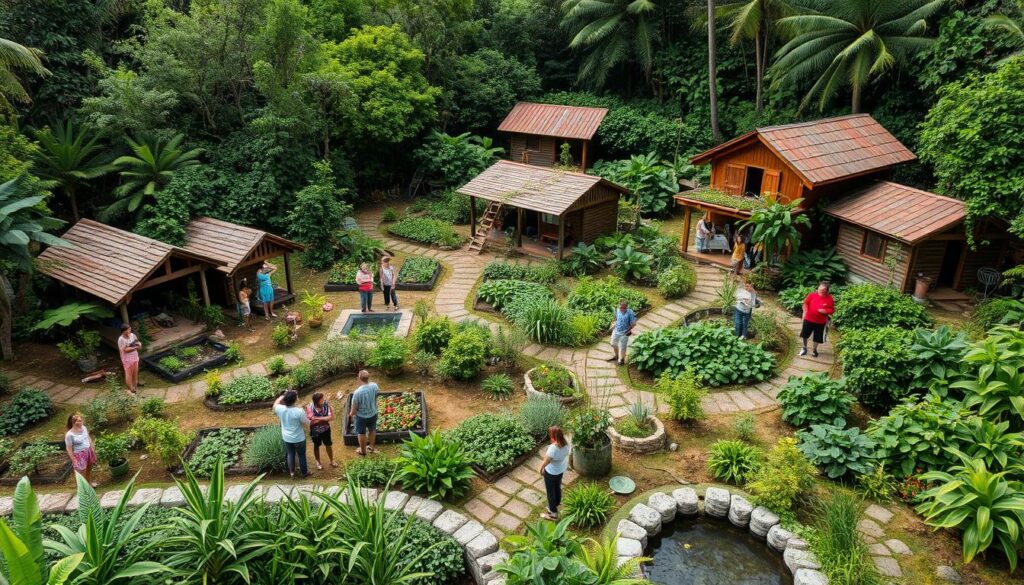
| Aspect | Benefits |
|---|---|
| Hands-on learning experiences | Increased guest engagement and awareness |
| Workshops and events on permaculture principles | Improved understanding of sustainable practices |
| Informative guest programs | Enhanced environmental sustainability and community support |
Assessing Environmental Impact
Checking how a resort affects the environment is key. It helps resorts lessen their harm and support sustainable living. Tools like environmental audits help find ways to improve and keep working on it.
Resorts can cut down on energy and water use. They can also reduce waste by recycling and composting. Supporting local nature and teaching locals about the environment are also important steps.
Using energy-saving bulbs and collecting rainwater are good ideas. Resorts can also use electric or hybrid cars to lower emissions. These actions help resorts be kinder to the planet and support local life.
| Category | Number of Projects |
|---|---|
| Positive Community Impact | 14 |
| Sustainable Design | 17 |
| Climate Action | 12 |
| Sustainable Operations | 10 |
| Sustainable Communities | 11 |
By using eco-friendly ways and supporting sustainable living, resorts can help the planet. They can also support local nature and help create a better future.
Building a Strong Team
Effective eco-friendly resort management needs a team that knows about sustainable hospitality. Training staff in permaculture is key for sustainability and helping local ecosystems. They learn about sustainable land use, renewable energy, and the value of biodiversity.
Resorts that adopt sustainable practices improve staff knowledge and create a better work place. This leads to a better guest experience and helps local economies. Eco-friendly management also boosts teamwork and collaboration among staff.
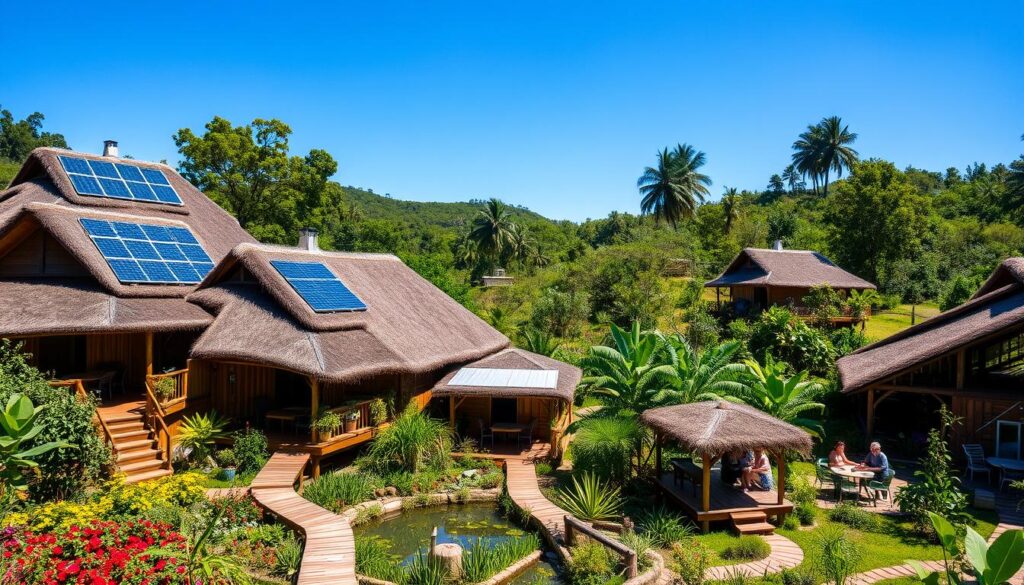
- Providing comprehensive training in permaculture practices and sustainable hospitality
- Fostering a positive work environment that encourages collaboration and open communication
- Encouraging staff participation in decision-making processes related to eco-friendly resort management
By focusing on staff training, eco-resorts can show a strong commitment to sustainability. This improves their reputation and attracts eco-conscious guests.
Future Trends in Permaculture Resorts
The need for green tourism is rising fast. Eco-resorts must keep up by using the newest permaculture resort operations and sustainable tourism practices. They’re starting to use solar and wind power. This makes them energy-independent and cuts down on pollution.
The hotel world is also focusing on building materials. They’re moving towards greener construction. This means using natural materials like wood and bamboo. It’s better for the planet and can even earn them credits for being green.
As we all try to save the environment, eco-resorts will lead the way. By adopting these new trends, they can become industry leaders. They’ll draw in guests who care about the planet. And they’ll help make our world a greener place.

